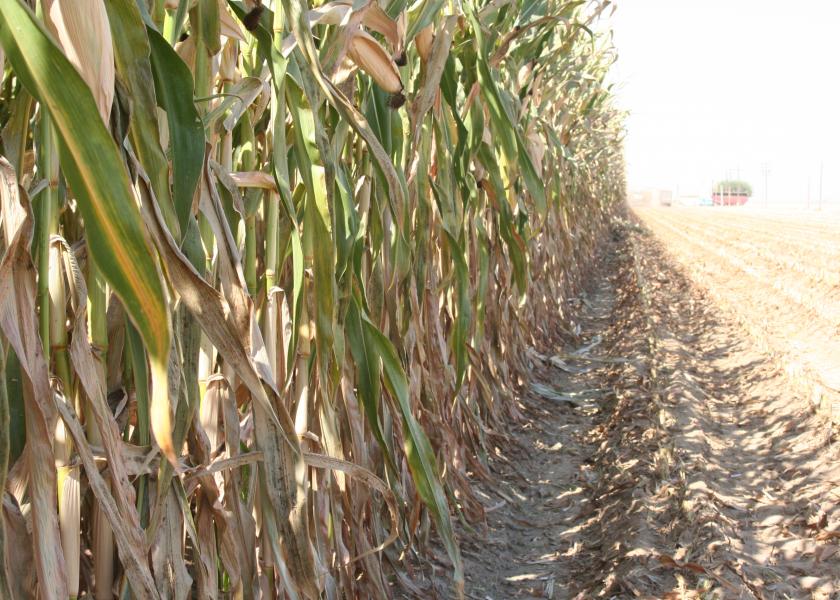Here's What An Early Frost Can Do To Corn Silage

The weather wasn’t kind to any farmer this spring, with too much rain significantly delaying corn planting and alfalfa harvest. Unfortunately dairy producers may feel the impact of these weather delays throughout the rest of the year and into next.
Many dairy producers already have mediocre alfalfa haylage in storage since it was probably harvested a couple weeks past optimal maturity. And if we have an early frost, as many predict, they will harvest poor quality corn silage as well. Since forages make up such an important staple of a lactating diet, producers will have to scramble to keep production at current levels.
If you planted corn after June 15 you should worry about an early frost.
“An 85-day corn silage hybrid reaches mid-silk at around 1,250 growing degree units,” says Jon Erickson, commercial agronomist for Mycogen Seeds located in central Wisconsin. “Generally, it is about 40 to 45 days after this time when silage harvest begins.” So if you planted that variety around July 1 in west central Wisconsin, that puts harvest at around October 15. The problem is, the average frost date for that region is October 12.
“So if we have a frost on the average frost date, or earlier, producers may need to be prepared to respond accordingly,” he says.
The real kicker will be how many growing degree units (GDU) we can accumulate between now and that first frost.
“We’ll need all the warm weather we can get to accumulate GDU’s for the crop to mature normally with good quality,” Erickson says. “This is especially important to starch accumulation in the late summer months where an early frost can shut down the plant, affecting ear fill.” Lower ear fill means lower starch values. Digestibility will be impacted as well, although not as much on BMR hybrids.
Even if we don’t have a killing frost prior to harvest, making corn silage in near-freezing temperatures will impact fermentation in storage.
“If we find ourselves chopping in near freezing temps, then the ensiled feed will ferment slowly, or not at all,” says John Goeser, director of nutritional research and innovation with Rock River Laboratories. “We could find ourselves feeding green corn silage well into next year, until temps warm to the point that the fermentation process can get going.”
Another issue will be molds and mycotoxins, Goeser says, as frost-killed plants begin to decompose before harvest.
“I’d be equally concerned about bacterial and yeast issues as I would be about molds and subsequent mycotoxin load they may produce,” he says. “A research backed inoculant or acid/chemical preservative at heavy levels is a must if ambient temperatures are between 35 to 40 degrees at harvest.”
Producers are going to have to stay on top of their corn crop if they want to be prepared for what an early harvest could bring to corn silage harvest.
“One thing producers can do is monitor the development of the corn after silking. I would suggest growers monitor this activity closely for each individual field,” Erickson says. He advises growers to keep a calendar listing 30 days after silking by field, and begin to monitor development and weather conditions until proper moisture for silage harvest is reached.
“Monitoring by field helps a grower plan harvest scheduling for the best quality,” Erickson says. “Or, if we get an early frost, to be prepared to execute a harvest strategy to get the best quality of a frost-shortened growing season.”
Watch grain development to judge when corn is ready for harvest. Even then, it’s good to know what stage you’re harvesting at so you know what to expect when it comes to feeding.
“Corn at the blister stage will be higher moisture, probably greater than 75%,” says Ted Koehler, Enogen feed ruminant nutritionist with Syngenta. “Even though the plant will look dead the stalk and ear will carry a lot of moisture.” He says checking the whole plant moisture before harvest is critical to avoid too much liquid runoff when the forage gets into storage. “Blister corn will contain a very high amount of sugar and lower lignification of fiber, making it a valuable feed. However, the same valuable sugar can cause spoilage at feed-out,” he says.
Waiting until the corn is at dough and dent stage will lead to drier forage, but be ready to harvest because moisture levels will drop rapidly, Koehler says. Still monitor whole plant moisture, he advises.
The following tools forecast GDD to projected frost dates:
• NorthEast: http://climatesmartfarming.org/tools/csf-growing-degree-day-calculator/
• Midwest: https://mrcc.illinois.edu/U2U/gdd/
• SouthEast: http://agroclimate.org/tools/growing-degree-days-calculator/
For more on frost damage, read:
Effects of a Freeze on Forages
What Precautions Should I Take Feeding Frosted Forages to Dairy Cattle?
Be Prepared: 2019 Corn Silage Will Be Different From Years Past







